Discover the 14 Most Dangerous Animals Patrolling Kansas’s Skies
Key Details
- There are over 483 different bird species soaring through Kansas’s skies.
- Kansas birds of prey patrol backyard bird feeders to hunt small birds or pick up toy breed dogs.
- Golden eagles across Kansas are capable of scaring local bears and coyotes away from their meals.
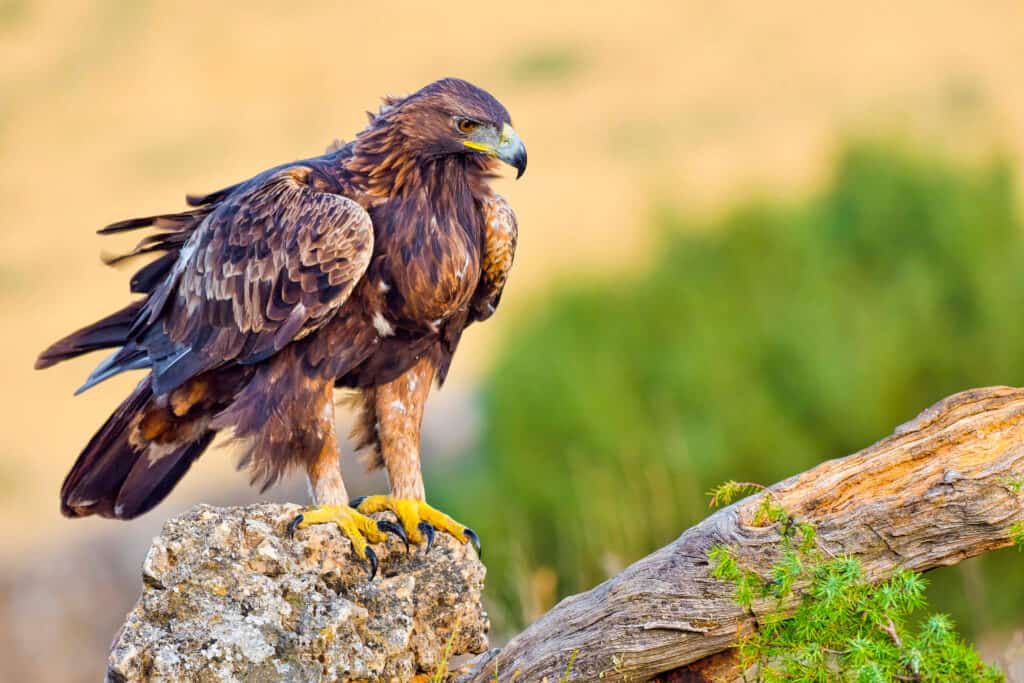
©Al Carrera/Shutterstock.com
Humans have advanced technology to deter and scare wildlife away from populated areas, but some animals have no fear. These raptors are so powerful that they have been symbols of strength, courage, and resilience for hundreds of years.
These birds of prey roam Kansas’s skies, casting shadows of danger and gloom. They worry families with small pets and leave farmers wondering if their poultry will be okay by morning. One bird in particular is strong enough to scare the local brown bear population just by flying overhead.
Follow along as we guide you through some of the most dangerous and powerful birds patrolling Kansas’s skies.
Where is Kansas?

Kansas is the 15th largest state in the United States. It is approximately 82,278 square miles, supporting a population of nearly two million people. Kansas is the 36th most populated state.
According to the Kansas Ornithological Society, a group dedicated to observing and admiring the local avian population, there are about 483 different species of birds patrolling the skies of the Sunflower State.
The most common bird species found in Kansas are:
- Hawks
- Eagles
- Falcons
- Owls
- Vultures
Hawks Found in Kansas
Hawks are birds of prey with broad, rounded wings and a long tail. They have a unique manner of hunting by swooping down and surprising their prey, chasing them for a short while before feasting on them.
Cooper’s Hawk

©rhfletcher/Shutterstock.com
Accipiter cooperii, the Cooper’s hawk, is a medium-sized hawk with short wings and long legs. These characteristics are part of the Accipiter group of birds that adapted to flying at high speeds with easy maneuverability. Their short wings and long tail allow them to nimbly fly through forests, dodging tree branches and obstacles to catch prey.
Cooper’s hawks hunt by watching prey from a distance. They strike and use their long talons and strong legs to break the bones.
Cooper’s hawks are a nuisance and danger to poultry farms as chicks, chickens, and roosters are easy targets. They also attack small animals like rabbits, ferrets, and guinea pigs. Families with toy-breed dogs must be careful letting their pups out in the yard alone, as they can also be targeted as prey.
Northern Harrier
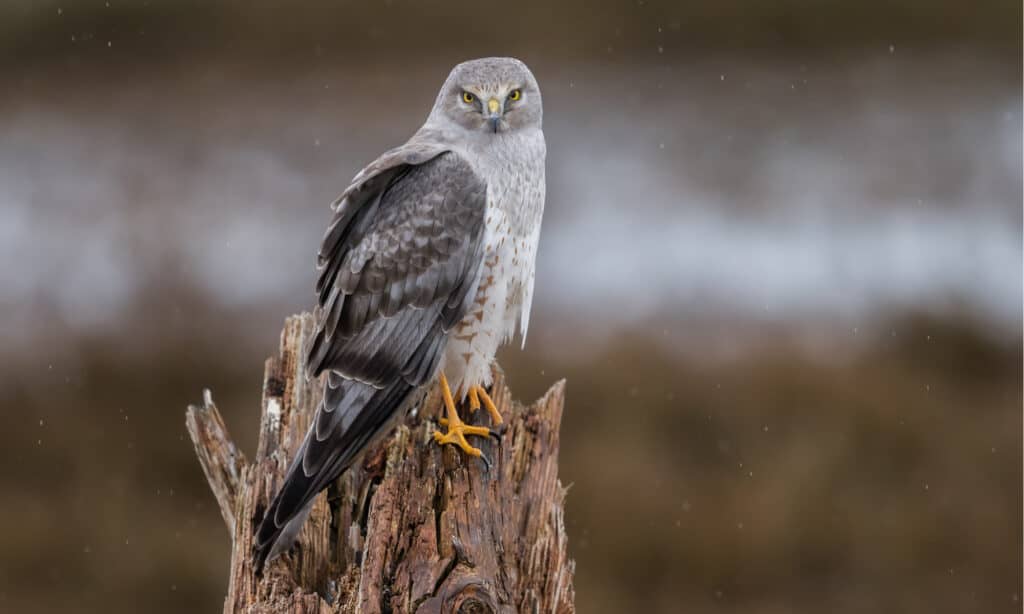
©Harry Collins Photography/Shutterstock.com
Circus hudsonius, northern harriers, are birds of prey that have a striking resemblance to owls. Despite being hawks, northern harriers rely on their hearing more than their vision to capture prey. They also possess a disk-shaped face more similar to those of owls than fellow hawks, which have a more pronounced and slender face.
Northern harriers fly low to the ground to catch small animals like mice and birds. They have a habit of catching prey in their long talons and drowning them in nearby streams, rivers, or lakes before consuming them.
Because they fly low to the ground, they often attack small dogs, indoor-outdoor cats, or poultry on farms.
Red-Tailed Hawk
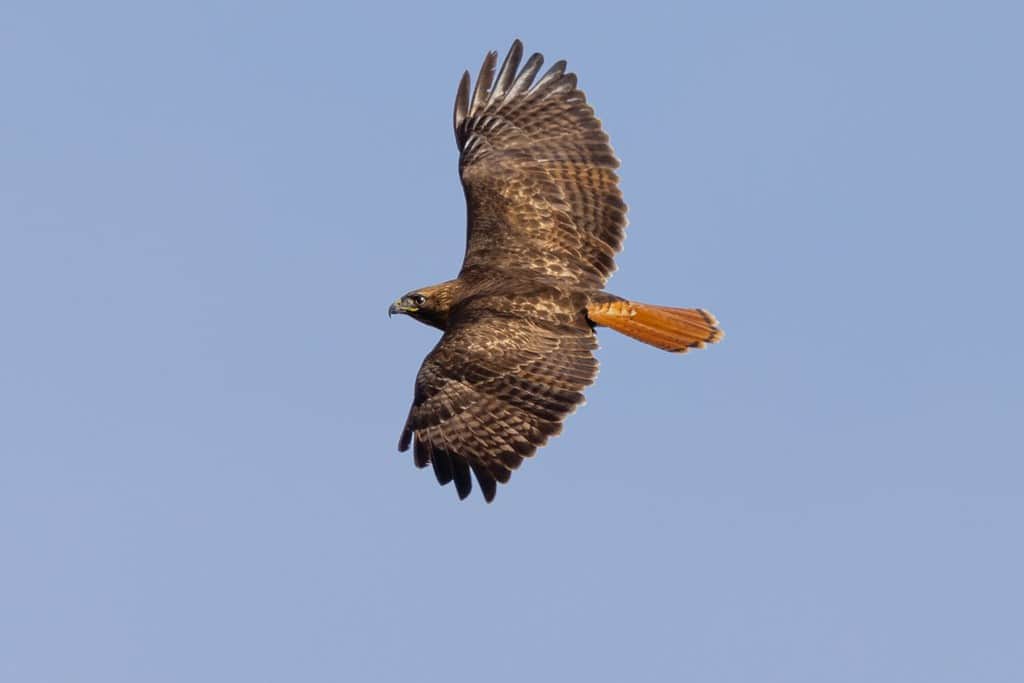
©ranchorunner/Shutterstock.com
Buteo jamaicensis, the red-tailed hawk, is the most common hawk found in Kansas and North America. Red-tailed hawks reside in dense forests and avoid heavily populated areas. These hawks have a famous caw, which is often used as a sound-effect in movies and televisions.
Male and female red-tailed hawks work together to catch prey. Each hawk guards opposite ends of a tree, waiting for a small bird or squirrel to approach. The hawks swoop down and attack the prey together, blocking any chance of escape.
Red-tailed hawks are not dangerous to humans, but dog owners hiking through the woods should keep their pets close and leashed.
Red-Shouldered Hawk
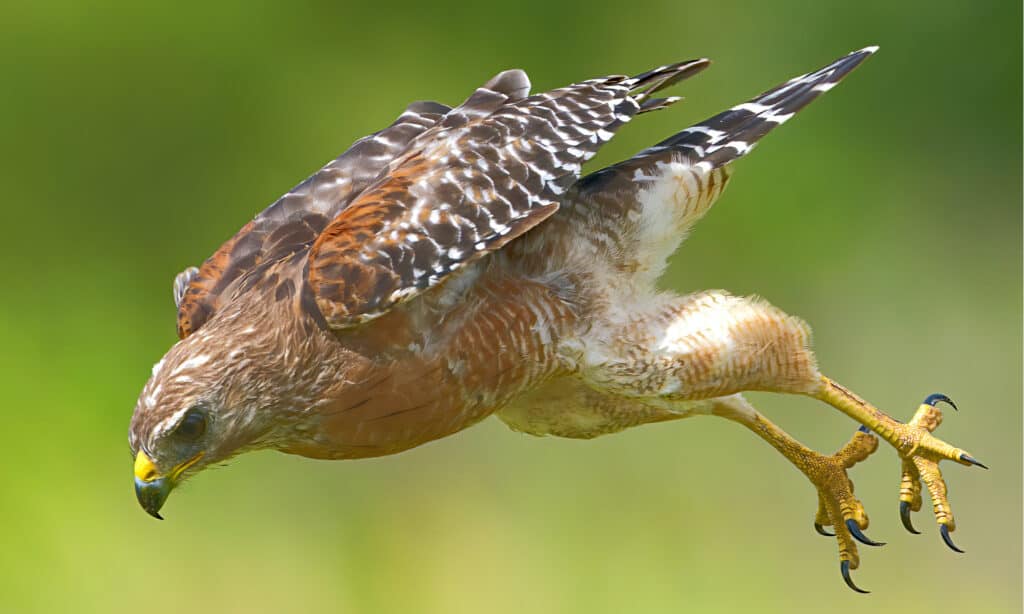
©Chase D’animulls/Shutterstock.com
Buteo lineatus, the red-shouldered hawk, is a close cousin to the red-tailed hawk. However, instead of a striking red pattern on the tail, the red-shouldered hawk has bright red feathers on its shoulders.
Red-shouldered hawks are very aggressive and will attack American crows or great-horned owls for territory or food.
Humans have little risk of red-shouldered hawks attacking them or their pets. However, they are capable of shooting their feces over their nests to keep them clean. Bird feces can be contaminated with harmful germs and bacteria. And no one likes bird poop falling from the sky.
Northern Goshawk
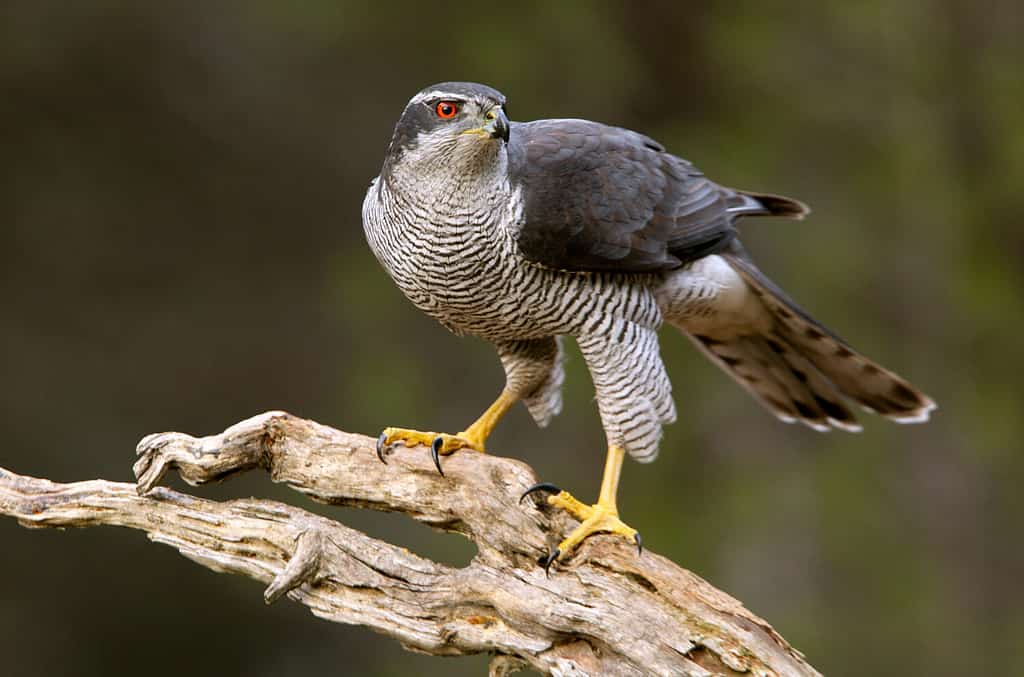
©Jesus Giraldo Gutierrez/Shutterstock.com
Accipiter gentilis, the northern goshawk, is a relative to the sharp-shinned and Cooper’s hawk. Goshawk is an Old English word meaning “goose hawk” or “cook’s hawk.” Northern goshawks were common hawks used for catching meals, especially geese.
They are very territorial and will attack anything to protect their nests, including humans. Northern goshawk attacks are low because they build their nests in deep forests with lush trees as cover. They will attack campers or children climbing a tree with a nest in it.
Sharp-Shinned Hawk
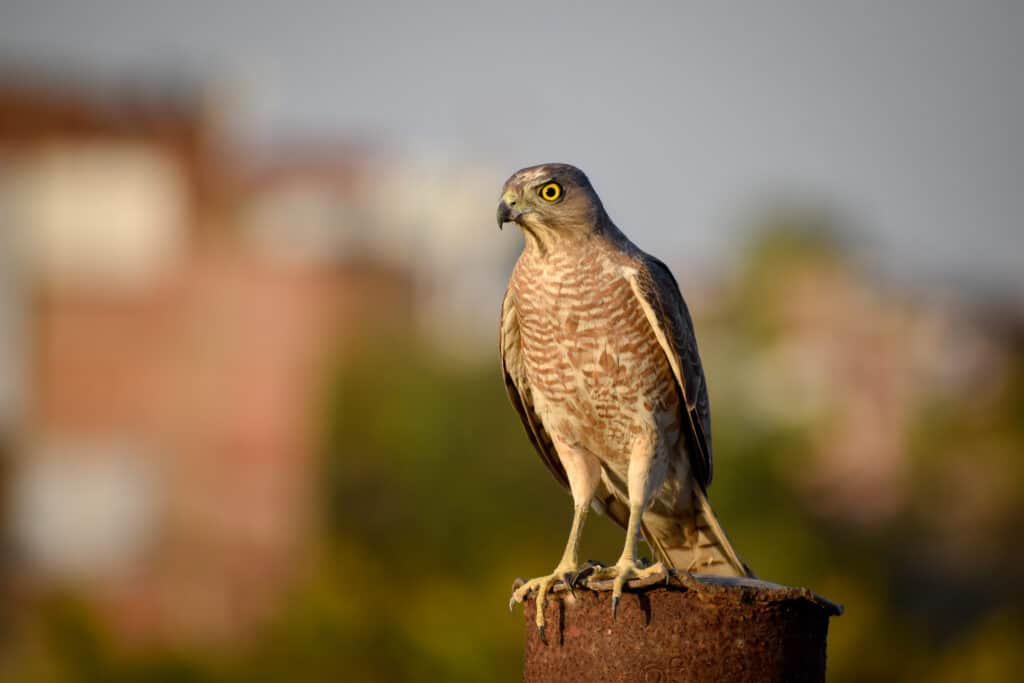
©Vizz Effect/Shutterstock.com
Accipiter striatus, the sharp-shinned hawk, is another close relative to the northern goshawk and Cooper’s hawk. Sharp-shinned hawks patrol populated areas to hunt small birds attracted to backyard feeders. They capture unsuspecting birds from yards. These hawks carry the prey somewhere safe and use their beak to pluck the feathers from their victim before eating it.
They are not directly dangerous to humans or pets.
Eagles Found in Kansas
Eagles are large, powerful, and majestic birds of prey that are symbols of strength and courage across many countries and Native American tribes. They are the toughest flying birds in the animal kingdom because of their large beaks, talons, and excellent eyesight.
Bald Eagles
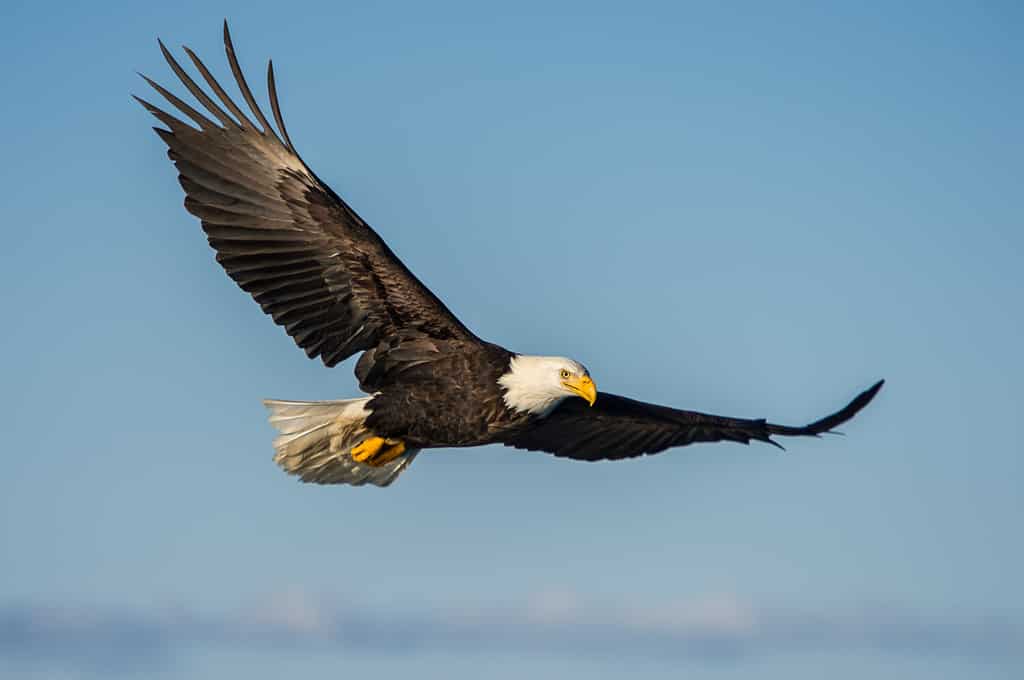
©FloridaStock/Shutterstock.com
Haliaeetus leucocephalus, the bald eagle, is the most iconic eagle in the entire species. It is the U.S. national bird, a symbol of strength, power, and grace patrolling the skies across North America.
The bald eagle population was placed on the endangered species list due to hunting and frequent pesticide use during the 1900s. Their population is recovering and no longer endangered in several parts of North America thanks to limited pesticide use and conservation laws.
Bald eagles are not directly dangerous to humans on a regular day. However, they can be a menace to fishermen, as they will swoop in and steal the fish for an easy meal.
Golden Eagles
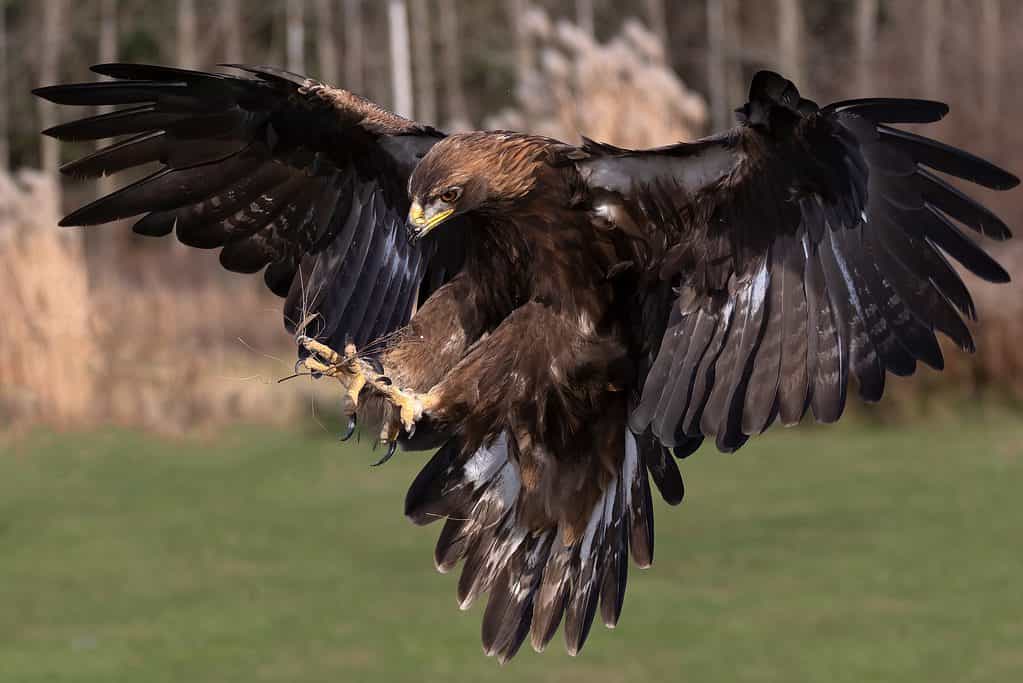
©Touched by light images/Shutterstock.com
Aquila chrysaetos, the golden eagle, is capable of scaring apex predators. Bald eagles are famous because of human intervention, but golden eagles are the real threat. They are the largest raptors in North America, capable of chasing away brown bears and coyotes by flying above them.
They feed on domestic livestock and any small mammal they can catch in their massive talons. When the bald eagle species was declining from pesticides, the golden eagle population was unchanged. Because they feed on specific animals unaffected by pesticides, the golden eagle population was never affected.
Falcons Found in Kansas
Falcons are raptors of the genus Falco, containing 40 species of birds that live on every continent except Antarctica. Traditionally, falcons are low risk to humans because they prefer to hunt in wooded areas. Humans created falconry, working alongside falcons to hunt prey or send messages.
Peregrine Falcon
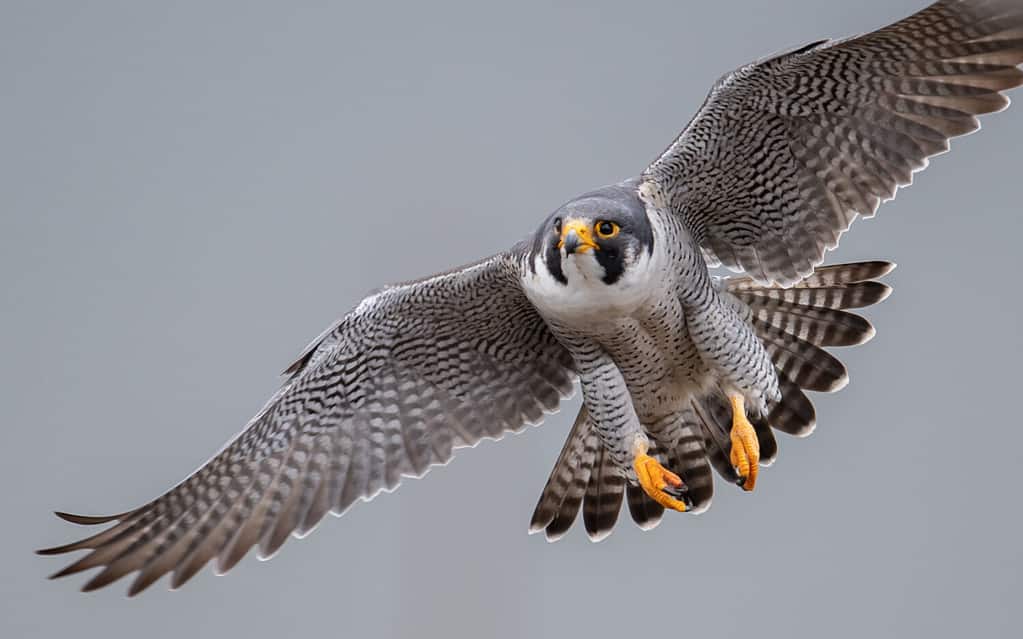
©Harry Collins Photography/Shutterstock.com
Falco peregrinus, the Peregrine falcon, is the most well-known falcon, in part because it is one of the fastest birds in the world. The Peregrine falcon is designed for optimal speed and wind resistance. It can reach approximately 200 mph when diving.
These birds are regularly seen in large cities and coastal areas hunting small birds. They pose little to no threat to humans on the ground, but airplanes must be watchful not to hit them. They were one of the many bird species affected by the pesticide plague in the 19th and 20th century.
Gyrfalcon
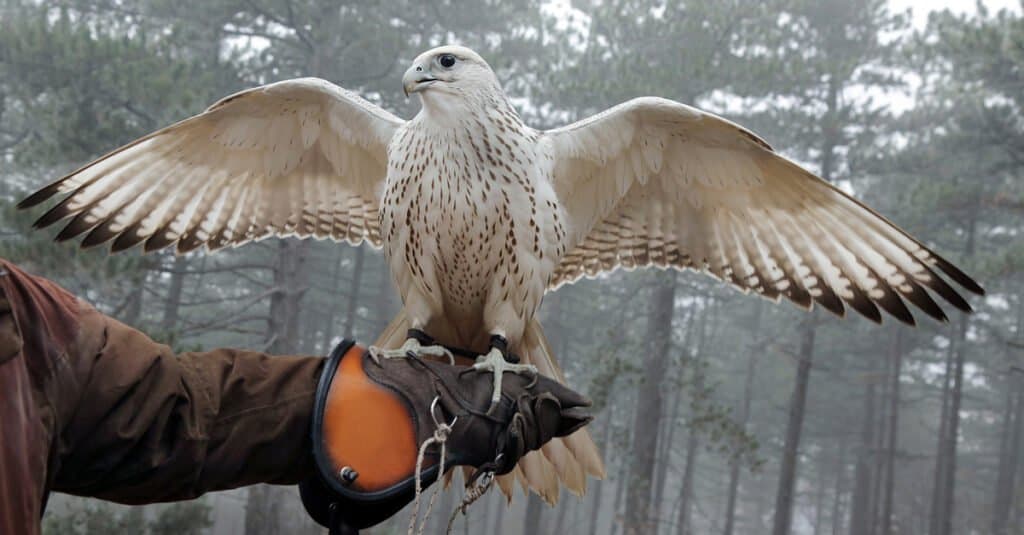
©Selena_ Q/Shutterstock.com
Falco rusticolus, the gyrfalcon, is the largest falcon in the world. They can reach 20-25 inches tall with a wingspan of nearly 4 feet across.
The gyrfalcon are large predators that hunt other birds like hawks, ravens, songbirds, and owls. They leave humans alone to hunt easier prey like small birds or toy breed dogs.
Owls Found in Kansas
Owls are nocturnal birds of prey with large forward-facing eyes, hooked beaks, and loud calls. Typically, owls are synonymous with themes of wisdom, patience, and elegance. They are stealthy and quiet as they hunt prey at night. Humans find them extremely mysterious because they are hard to spot. People usually know they’re nearby due to their iconic call of hoots or squarks.
Barn Owls
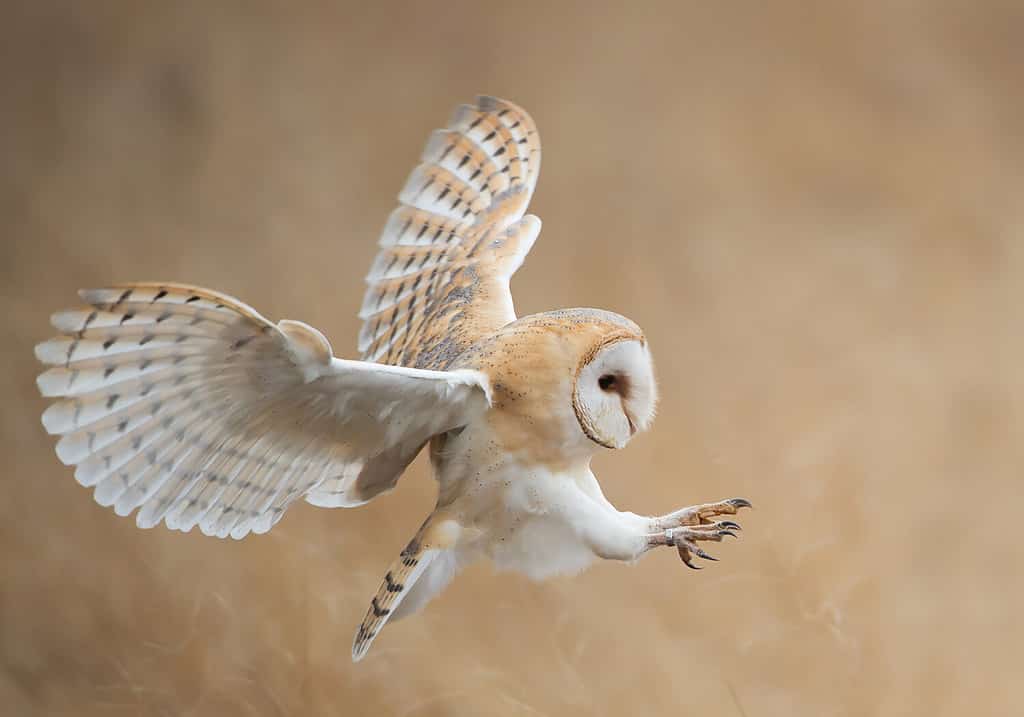
©MZPHOTO.CZ/Shutterstock.com
Tyto alba, the barn owl, is a small-sized owl that nests within small spaces like trees or the upper rafters of barns. Recent habitat loss has the barn owl population in decline, placing them as a low concern. Thankfully, there are thousands of barn owl species around the world and there is minimal chance of the population going extinct.
Barn owls pose no danger to humans or pets because of their small size. In fact, they benefit farmers by eating mice and rodents that plague their crops.
Snowy Owl
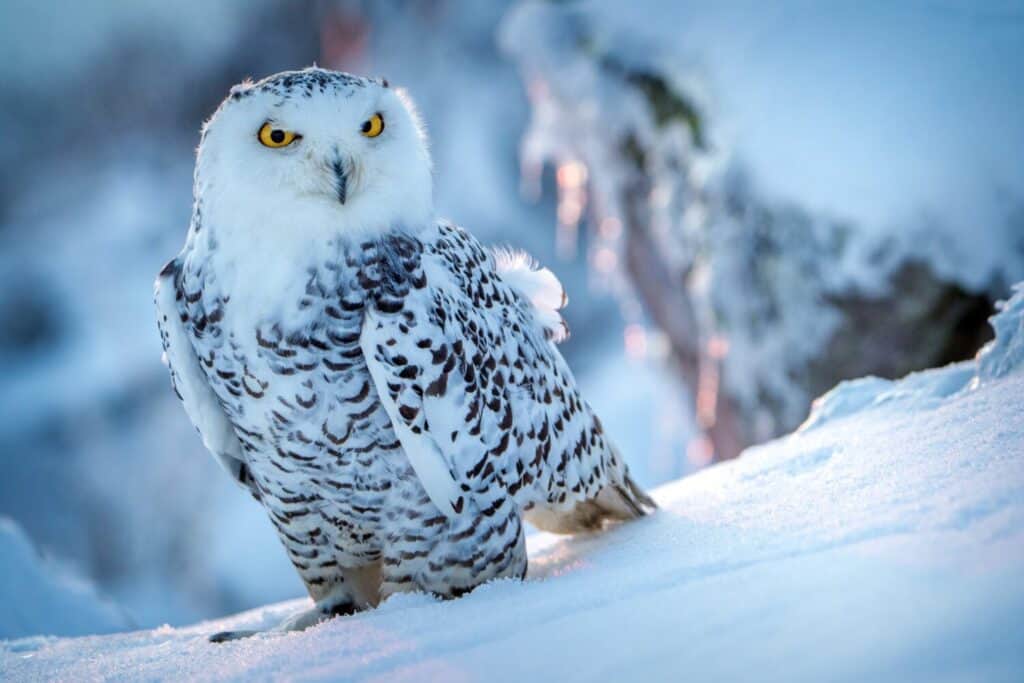
©jurra8/Shutterstock.com
Bubo scandiacus, the snowy owl, is the most majestic and mysterious of the owl species. They are native to North America but are the most difficult to find. Their population is decreasing due to habitat loss from agriculture and urbanization. When forced into other territories, they are unable to blend their snow-white feathers into the environment.
Snowy owls will fight other birds for territory and food. Unlike other owls, they are diurnal, meaning they hunt during the day and night. They are the heaviest North American owl, weighing 4.5 pounds.
Snowy owls pose little to no threat to humans. In fact, anyone wishing to see one is forced to endure restless nights, exhaustion, and bitter cold to catch a glimpse.
Great-Horned Owl
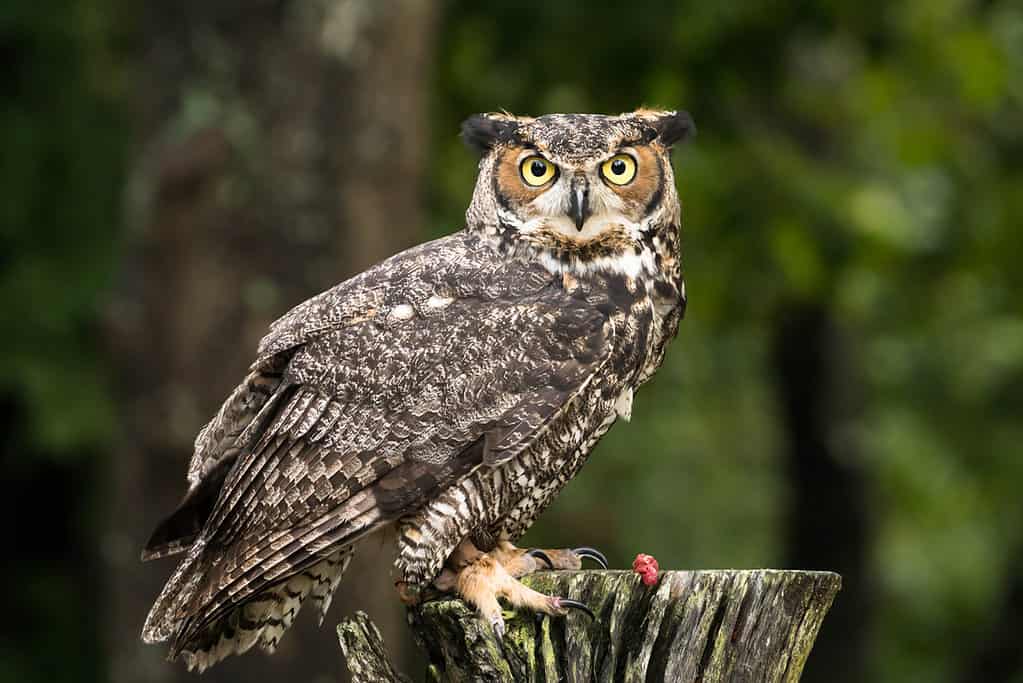
©iStock.com/makasana
Bubo virginianus, the great-horned owl, is the famous owl commonly featured in fairy tales and kid’s stories. They are easily found across North America and are one of the few owl species that pose a threat to humans.
Great-horned owls will attack animals larger than themselves for a meal. Typically, the prey has to be large enough to be eaten and taken down, so humans are not directly attacked. However, small dogs, indoor-outdoor cats, small animals, and poultry are at considerable risk of great-horned owls swooping in. Their talons can exert 28 pounds of force, easily capable of crushing smaller and weaker prey.
Notable Bird of Kansas
While these birds are not dangerous to humans in a direct way, they serve a purpose that helps and protects people and pets. Without them, there may be more disease from decaying flesh and meat poisoning the soil or water supply.
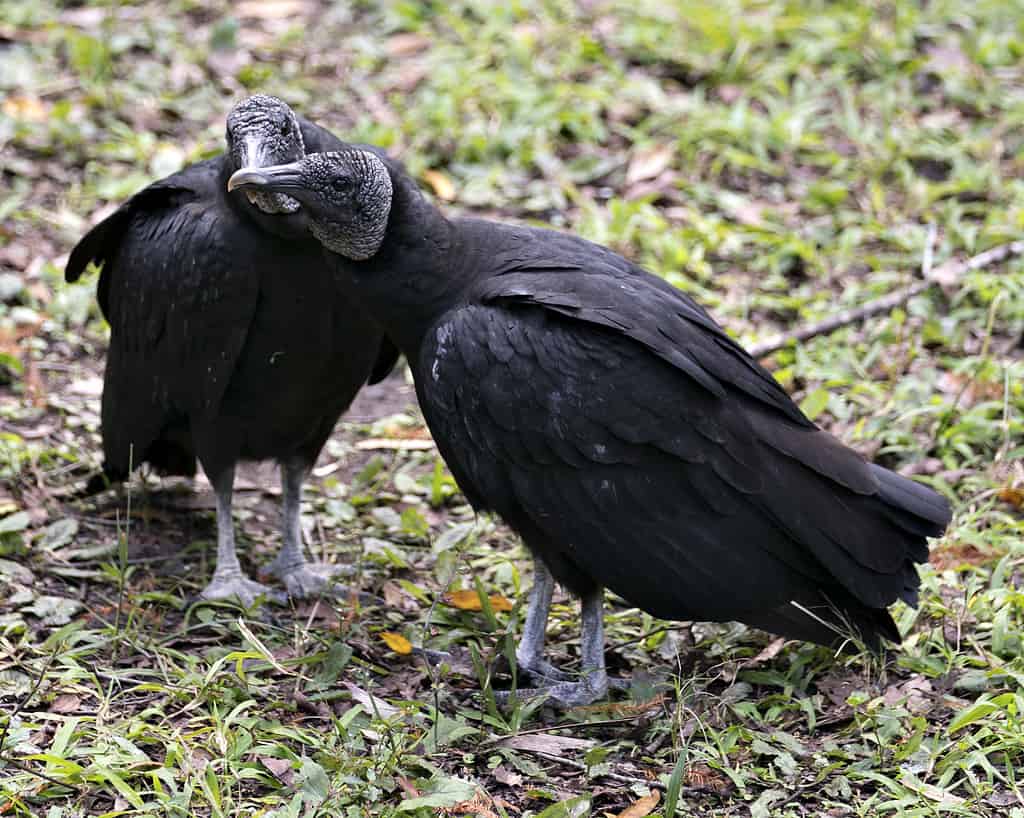
©iStock.com/Rejean Bedard
The black vulture (Coragyps atratus) is a relative to the turkey vulture and native to North America. They are very social birds, working together to find and share a meal. Black vultures spread their large 4.4-5.5-foot wingspan in a specific manner to inform other vultures it is safe to eat.
Without black vultures feasting on decaying flesh and meat, the bacteria produced from a rotting carcass can infest water supplies.
Are These Birds Dangerous in Kansas
Large birds of prey are no real threat to humans. Most birds have learned to avoid humans while building nests in populated areas. The American crow has adapted to living alongside humans, as well. In fact, these smart birds break seeds open on vehicles!
Birds of prey recognize humans are not suitable prey. However, humans are excellent sources of seeds and other food, which attracts suitable prey like small birds and rodents.
There is no need to be afraid of the birds lurking in the sky over Kansas. They have adapted to living comfortably around humans, using us as a means of locating prey. Keep that in mind next time you look into the sky and wonder what birds could be watching you from above.









